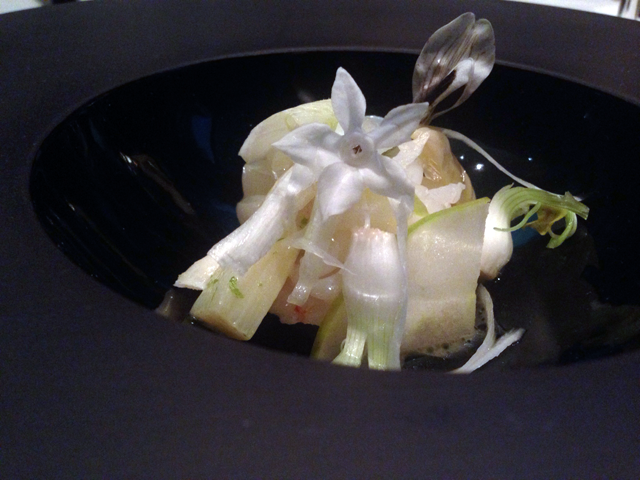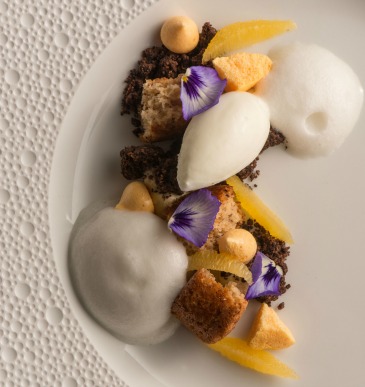Signs Of Spring: Edible Flowers
By Melissa Wiley in Food on Apr 9, 2014 3:00PM

Lobster, tarragon, earl grey fruit loops with cashew milk and a violetta flower at Elizabeth Restaurant (Credit Melissa McEwen)
Spring means flowers, not just splashing color around peeling park benches but beautifying your plate while adding flavorful accents to a vast range of cuisine.
“Using edible flowers simply for ornamentation is superfluous in my opinion. I like flowers with unique and interesting flavors or aromas. I like honeysuckles for their fragrance and their flavor, violets for their fragrance and borage, horsemint and nasturtiums for their flavor,” says Big Jones’ Paul Fehribach.
That said, they are pretty to look at as well as key elements of warm-weather degustation.
Pastry Chef Ann Shovers of The Publican enthuses, "Local flowers in spring and summer are nature's candy. Violettas literally taste like bubblegum."
But as moto's Executive Chef Richie Farina explains, flowers supplement some foods better than others. “Some flowers have a lot of acid, such as oxalis and begonias. Others such as allium have an onion flavor. I like to pair flowers with light seafood and vegetables but feel that meats overpower them. A lot of flowers also work really well with dessert.”
Flowers’ delicacy limits their culinary utility while also underscoring their allure. The symbiosis between chefs and flora is consequently a pragmatic one built on charm, as chefs select the best foods with which to pair these emblems of spring.
“I think the best flavor profile has to be based on the dish itself,” avers Elizabeth’s Iliana Regan. “So many of them are lovely in companionship with the dish you put them on. Nasturiums are great on savory dishes, because they add a lovely peppery quality.”
Paul Fehribach similarly reserves honeysuckles, violets and nasturtiums—with their pungent, almost turnip-like flavor—primarily for salads and ice creams, while Farina prefers to save his fast-wilting blossoms for meal’s beginning or end, where lighter preparation ensures the subtlest floral accents will still shine. Floriole’s Sandra Holl likewise sprinkles fresh flowers on her cakes and tarts, especially when spring is just finding its footing and the landscape is still short on color.
“Flowers are beautiful and add a pop of color that is irresistible,” she says while adding, “Flavor is very important. I would never use chive flowers in a sweet application, for instance, because they taste oniony.”

"The White North Star" : butter poached escolar with sepia, lily and white asparagus, in a sake and coconut broth at Sixteen (Credit Melissa McEwen)
Shovers takes an equally practical approach, saying, “Marigolds are great with citrus desserts. Coriander flowers are interesting with carrot, vanilla and mellow-flavored items. But I don't use them on every plate—I try not to add anything that’s not needed. Longevity is also important. Flowers aren't cheap, so we try to use flowers that will give us at least a couple days’ use. Ones that tend to wilt quickly will usually get candied.”

BOKA Pastry Chef Genie Kwon's coffee cremeux, hazelnut, whiskey foam and milk ice cream (credit Anthony Tahlier)
Regan echoes the virtues of herbal flowers, saying, “Thyme, mint and coriander are my favorite flowers to work with because of the great impact they have on flavor, tasting so much just like the herb they came from but also with that great aroma.”
Pretty as a peach but far from hardy, local fresh flower blossoms are sadly in short supply come winter and this spring's chill Chiberia aftermath. Fortunately, greenhouses pick up considerable slack.
“During the growing season, we get the majority of our flowers from our rooftop garden,” says Holl. “Since nothing is growing currently, however, we are ordering violas, borage and pineapple sage grown in greenhouses from Werp Farms in northern Michigan.”
Fehribach, meanwhile, lets the flowers to come to him, buying almost all his edible blossoms exclusively from Spence Farms and Green City Market, while Farina also makes a conscious effort to source from local purveyors. Regan relies on local growers as well as Elizabeth’s personal garden plot, while Chicago’s own Urban Till supplies BOKA with its floral eats, customizing its products to the restaurant’s needs in specific quantities, designed, Kwon says, to help eliminate waste.
Shovers simply rolls with the seasons, sticking to dehydrated fruit chips and micro herbs as garnishes during colder months and relying on Gary Comer Youth Center in the warmer ones, about which she gushes, “You could put them on a scoop of vanilla ice cream and call it a finished dessert. And the kids there get such enjoyment from gardening that it makes them even more special.”
Few joys, however, match the organic pleasure of growing your own blossoms. And though not all are edible, there’s no harm in planting some you can taste as well as collect into bouquets.
“For home cooks, I recommend using chive flowers in salads, pastas or grilled meats,” suggests Holl. “They are easy to find at the market, don't cost much, and are so pretty and tasty. For a sweet garnish, dried lavender flowers are great because a little goes a long way and they keep in the cupboard. If you have a garden or even a planter box, I recommend using the flowers from most herbs in whatever you are cooking. So often we ignore the dill flowers or thyme flowers, but they have great flavor and add a little beauty to every dish.”
Regan, meanwhile, has three words for you: nasturtium, viola, borage. “All three are easy to grow and have a great culinary impact. Nasturtiums for a peppery flavor, viola for a minty one and borage for a cucumber kick.”
And when all else fails, forage. “Honeysuckles are abundant, easy to forage, and therefore free. You can use them to make honeysuckle water to flavor ice creams and sorbets or use them in salads,” suggests Fehribach.
For his part, Farina recommends pansies, oxalis and wild allium to home cooks looking to put some spring on their plate. “Most can be found walking around Chicago and so are also on the least expensive side.”